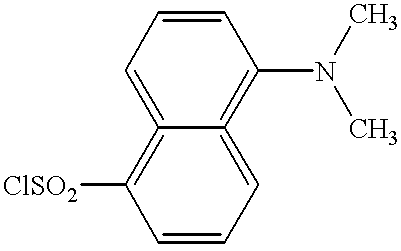Detectable polymers and methods for detecting polymers in Aqueous systems
a detection method and polymer technology, applied in the direction of chemical indicators, instruments, detergent compounding agents, etc., can solve the problems of low detection rate, lack of selectivity, and false results for components of the aqueous system other than polymers, so as to minimize the contamination of the product
Inactive Publication Date: 2001-06-26
ROHM & HAAS CO
View PDF10 Cites 31 Cited by
- Summary
- Abstract
- Description
- Claims
- Application Information
AI Technical Summary
Benefits of technology
If desired, it is possible to incorporate polyethylenically unsaturated compounds into the polymerization. Polyethylenically unsaturated compounds function as crosslinking agents and will result in the formation of higher molecular weight polymers.
One common method for reducing the level of residual monomer in a polymer mixture is post-polymerization addition of one or more initiators or reducing agents which can assist scavenging of unreacted monomer.
Problems solved by technology
However, the level of active polymer is not simply a function of how much polymer has been added.
One of the problems associated with detecting polymers in aqueous systems is that the polymers are generally present at very low levels, from 500 down to less than 5 parts per million (ppm).
Another problem associated with detecting polymers in aqueous solutions is that the detection methods frequently lack selectivity and may give false results for components of the aqueous system other than polymers.
However, this assumption is undermined by the fact that the fate of the tracer compound and the fate of the polymer in the aqueous system may differ.
This approach has the drawback of additional processing steps in preparing the fluorescent monomer.
Also, the presence of the fluorescent moiety, which is usually a fairly bulky, hydrophilic group, may interfere with the performance characteristics of the resulting polymer.
Method used
the structure of the environmentally friendly knitted fabric provided by the present invention; figure 2 Flow chart of the yarn wrapping machine for environmentally friendly knitted fabrics and storage devices; image 3 Is the parameter map of the yarn covering machine
View moreImage
Smart Image Click on the blue labels to locate them in the text.
Smart ImageViewing Examples
Examples
Experimental program
Comparison scheme
Effect test
example 2
The procedure of Example 1 was repeated. The data appear in Table I below.
example 3
The procedure of Example 1 was repeated except that nitrogen was bubbled through the reaction mixture throughout the course of the polymerization. The data appear in Table I below.
example 4
The procedure of Example 1 was repeated except that the levels of 2,2'-azobis(2-amidinopropane) dihydrochloride were doubled. The data appear in Table I below.
the structure of the environmentally friendly knitted fabric provided by the present invention; figure 2 Flow chart of the yarn wrapping machine for environmentally friendly knitted fabrics and storage devices; image 3 Is the parameter map of the yarn covering machine
Login to View More PUM
| Property | Measurement | Unit |
|---|---|---|
| temperature | aaaaa | aaaaa |
| temperature | aaaaa | aaaaa |
| weight | aaaaa | aaaaa |
Login to View More
Abstract
Polymers having amine-thiol terminal moieties are provided. The amine-thiol terminal moieties are imparted by using amine-thiols as chain transfer agents in aqueous addition polymerizations. The polymers are useful as mineral dispersants, as water-treatment additives for boiler waters, cooling towers, reverse osmosis applications, sugar refining, paper production, geothermal processes and oil wells, and as detergent additives acting as builders, anti-filming agents, dispersants, sequestering agents and encrustation inhibitors.
Description
The present invention is directed to detectable polymers and methods for detecting polymers in aqueous systems. In particular, the present invention concerns water-soluble polymers containing a pendant amine group capable of reacting with amine-reactive labels.Water-soluble polymers are used in many aqueous systems, for example, as mineral dispersants, as water-treatment additives for boiler waters, cooling towers, reverse osmosis applications, sugar refining, paper production, geothermal processes and oil wells, and as detergent additives acting as builders, anti-filming agents, dispersants, sequestering agents and encrustation inhibitors. In many of these aqueous systems it is desirable to know the level of polymer in the system. However, the level of active polymer is not simply a function of how much polymer has been added. The polymer may have adhered to a surface or may have flocculated out with sediment, or the polymer itself may have decomposed. Because polymers generally ad...
Claims
the structure of the environmentally friendly knitted fabric provided by the present invention; figure 2 Flow chart of the yarn wrapping machine for environmentally friendly knitted fabrics and storage devices; image 3 Is the parameter map of the yarn covering machine
Login to View More Application Information
Patent Timeline
 Login to View More
Login to View More Patent Type & Authority Patents(United States)
IPC IPC(8): C02F1/56C02F5/10C02F1/54C08F8/30C08F8/00C08F8/34C08F2/38C11D3/37
CPCC02F1/56C02F5/10C08F2/38C08F8/34C11D3/3769C08F8/30Y10T436/13
Inventor FU, ZHENWENKELLER, LORRAINE HOLOWACHWEINSTEIN, BARRY
Owner ROHM & HAAS CO
Features
- R&D
- Intellectual Property
- Life Sciences
- Materials
- Tech Scout
Why Patsnap Eureka
- Unparalleled Data Quality
- Higher Quality Content
- 60% Fewer Hallucinations
Social media
Patsnap Eureka Blog
Learn More Browse by: Latest US Patents, China's latest patents, Technical Efficacy Thesaurus, Application Domain, Technology Topic, Popular Technical Reports.
© 2025 PatSnap. All rights reserved.Legal|Privacy policy|Modern Slavery Act Transparency Statement|Sitemap|About US| Contact US: help@patsnap.com



